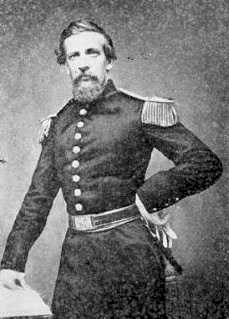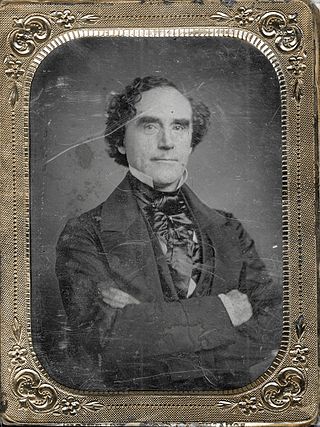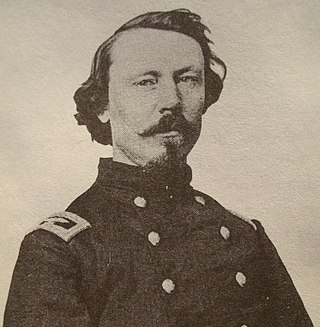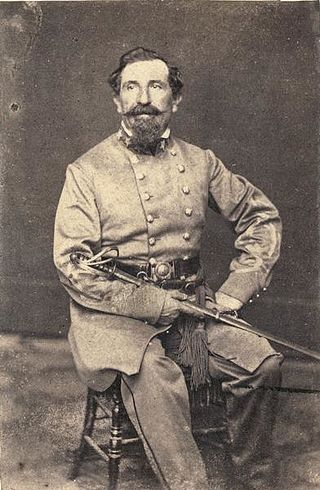
The Camp Jackson affair, also known as the Camp Jackson massacre, occurred during the American Civil War on May 10, 1861, when a volunteer Union Army regiment captured a unit of secessionists at Camp Jackson, outside the city of St. Louis, in the divided slave state of Missouri.

The Battle of Carthage, also known as the Engagement near Carthage, took place at the beginning of the American Civil War on July 5, 1861, near Carthage, Missouri. The experienced Colonel Franz Sigel commanded 1,100 Federal soldiers intent on keeping Missouri within the Union. The Missouri State Guard was commanded by Governor Claiborne F. Jackson himself and numbered over 4,000 soldiers led by a hero of Mexico, Sterling Price, along with 2,000 unarmed troops who did not participate in the battle.

The First Battle of Boonville was a minor skirmish of the American Civil War, occurring on June 17, 1861, near Boonville in Cooper County, Missouri. Although casualties were extremely light, the battle's strategic impact was far greater than one might assume from its limited nature. The Union victory established what would become an unbroken Federal control of the Missouri River, and helped to thwart efforts to bring Missouri into the Confederacy.

The Missouri State Guard (MSG) was a military force established by the Missouri General Assembly on May 11, 1861. While not a formation of the Confederate States Army, the Missouri State Guard fought alongside Confederate troops and, at various times, served under Confederate officers.

John Stevens Bowen was an American career Army officer who later became a general in the Confederate Army and a commander in the Western Theater of the American Civil War. He fought at the battles of Shiloh, Corinth, and the Vicksburg Campaign. He is often said to have died just as his abilities were gaining attention.
The 66th Illinois Veteran Volunteer Infantry Regiment (Western Sharpshooters) originally known as Birge's Western Sharpshooters and later as the "Western Sharpshooters-14th Missouri Volunteers", was a specialized regiment of infantry sharpshooters that served in the Union Army during the American Civil War. The regiment was intended, raised, and mustered into Federal service as the Western Theater counterpart to Army of the Potomac's 1st and 2nd United States Volunteer Sharpshooters ("Berdan's Sharpshooters").
Alexander Early Steen was a career American soldier from Missouri who served in the United States Army in the Mexican–American War. He rejoined the army in 1852 and served until he resigned to join the Confederate forces on May 10, 1861. He served as a general in the secessionist Missouri State Guard forces and as a colonel and acting brigadier general in the Confederate States Army during the American Civil War. He was killed in the Battle of Prairie Grove.

Meriwether Lewis Clark was an architect, civil engineer and politician. He was also a military officer in the Mexican–American War and the American Civil War. He was a son of famous explorer William Clark.

Colton Greene was an officer of the Confederate States Army who commanded cavalry in the Trans-Mississippi Theater of the American Civil War. After the Civil War Greene pursued several successful civic projects and public functions in Memphis, Tennessee.
The 2nd Missouri Infantry Regiment was an infantry regiment, formed from a voluntary regiment using the same name, that served in the Union Army during the American Civil War.

Patrick Emmet Burke was a lawyer, Missouri state legislator, and Civil War officer. He commanded the Western Sharpshooters Regiment and the 2nd Brigade, 2nd Division, XVI Corps, Army of the Tennessee.

The 1st Missouri Infantry Regiment evolved from one of several unofficial pro-Unionist Home Guards militia formed in St. Louis in the early months of 1861 by Congressman Francis Preston Blair, Jr. and other Unionist activists. The militia that would become the First Missouri was largely composed of ethnic Germans, although Companies K and I had significant numbers of native born American citizens and Irish-Americans. Although initially without any official standing, beginning on April 22, 1861, the four "underground" militia regiments Blair helped organize were sworn into Federal service at the St. Louis Arsenal by Captain John Schofield acting on the authority of President Lincoln.
The 1st Missouri Infantry was an infantry regiment that served in the Confederate States Army during the American Civil War. Originally commanded by Colonel John S. Bowen, the regiment fought at the Battle of Shiloh, where it was engaged near the Peach Orchard on April 6, 1862. On April 7, during the Union counterattacks at Shiloh, the regiment was instrumental in preventing the Washington Artillery from being captured. The regiment was next engaged at the Second Battle of Corinth, where it outflanked several Union positions. On the second day at Corinth, the regiment was only minimally engaged. On November 7, the 1st Missouri Infantry was combined with the 4th Missouri Infantry to form the 1st and 4th Missouri Infantry (Consolidated), as a result of heavy battle losses in both regiments.

Given Campbell was a Confederate officer best known for leading the final escape of Jefferson Davis in the last days of the Civil War.
The Adjutant General of Maryland is the head military official of the Maryland National Guard, the Maryland Defense Force, and any other military or paramilitary units that may be maintained by the State of Maryland. The adjutant general is responsible for the military department's budget and maintains all State-owned armories in Maryland.

The 3rd Missouri Infantry Regiment was an infantry regiment that served in the Union Army during the American Civil War. It arose from a group of volunteers who were active from April to September 1861.

Adolphus Heiman was a Prussian-born American architect and soldier; later becoming a Confederate officer during the American Civil War.

The 3rd Missouri US Reserve Corps Infantry Regiment evolved from one of several unofficial pro-Unionist militia units formed semi-secretly in St. Louis in the early months of 1861 by Congressman Francis Preston Blair, Jr. and other Unionist activists. The organization that would become the Third U.S.R.C was largely composed of ethnic Germans, who were generally opposed to slavery and strongly supportive of the Unionist cause. 20 percent of the men of the regiment were "native" U.S. citizens. Although initially without any official standing, beginning on April 22, 1861, the Unionist regiments Blair helped organize were sworn into Federal service at the St. Louis Arsenal by Captain John Schofield acting on the authority of President Lincoln.
Slayback's Missouri Cavalry Regiment was a cavalry regiment of the Confederate States Army during the American Civil War. Originally formed as Slayback's Missouri Cavalry Battalion, the unit consisted of men recruited in Missouri by Lieutenant Colonel Alonzo W. Slayback during Price's Raid in 1864. The battalion's first action was at the Battle of Pilot Knob on September 27; it later participated in actions at Sedalia, Lexington, and the Little Blue River. In October, the unit was used to find an alternate river crossing during the Battle of the Big Blue River. Later that month, Slayback's unit saw action at the battles of Westport, Marmiton River, and Second Newtonia. The battalion was briefly furloughed in Arkansas before rejoining Major General Sterling Price in Texas in December. Probably around February 1865, the battalion reached official regimental strength after more recruits joined.
Samuel Churchill Clark was a Confederate military officer who was killed during the American Civil War in the Battle of Pea Ridge.












